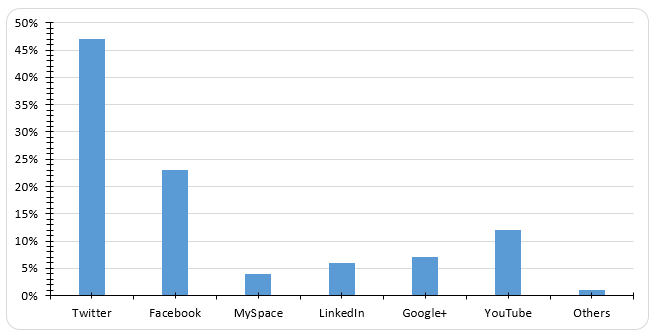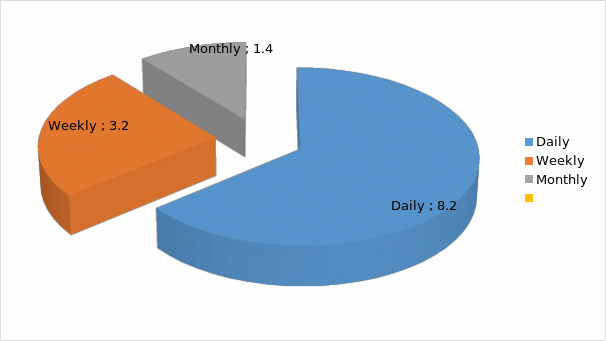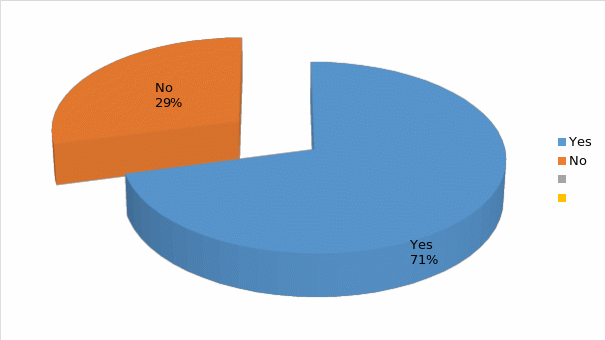Research Problem
In recent times, college staff and students have adopted various social networking sites and tools for educational purposes. In this regard, social networking sites and tools have a significant impact on professional development and project collaboration.
Although college staff and students are now pushing learning beyond the borders of the classroom through social networking, many universities do not allow access to such sites. In this context, critical questions in relation to the use of social networking sites emerge. For example, concerns as to whether social networking sites influence students’ educational performance in a positive or adverse manner require urgent attention.
Research Questions
The following questions guide the study on social networking sites and the related impact on students’ performance at King Saud University.
Does the use of the social network in teaching imply a significant increase in student learning? Is there a relation between the use of social networking sites and students’ performance? What are the advantages and disadvantages of social networking sites? Is there a relationship between the frequency of social sites’ usage and the students’ performance? Is there a relationship between the attitude of the student toward social networking sites as an effective education tool and student performance?
Research Importance
As indicated earlier, social network sites have revolutionized teaching and learning practices and are considered alternative education methods. In addition, social networking sites generate new ways of organization, cooperation, and training among college students and staff members. From this perspective, the following study provides a critical foundation for further research on social networking sites and related impacts on students’ performance.
Research Objectives
The following are considered as major research objectives.
- Understanding the social networking sites and their roles.
- Understanding the impact of social networking sites on the education system
- Identifying the advantages and disadvantages of the social networking sites in relation to the students’ academic performance.
- Examine the effectiveness of the social networking tools in regard to knowledge sharing and students’ general awareness.
Research Hypothesis
Hypothesis 1
There is no significant relationship between the frequency of social networking sites’ usage and students’ performance.
Hypothesis 2
There is no significant relationship between using social networking sites and students’ performance based on gender.
Hypothesis 3
There is no significant relationship between using of social networking sites by educators and the students’ performance.
Hypothesis 4
There is no significant relationship between students’ attitudes towards social networking sites as effective educational tools and academic performance.
Methodology
The study utilized a methodological design that combines both qualitative and quantitative techniques. However, the quantitative part was significantly over-utilized compared to the qualitative. Nonetheless, this was done to extrapolate the results of the surveyed population as a whole. The essential method in this work was a descriptive survey of a sociological nature.
The surveyed population was constituted by undergraduates registered at King Saud University. The population size was set at more than 10, 000 students, according to the statistical figures at the university’s official website. Importantly, the statistics are depicted as the latest entries of the institution.
The sampled population is spread over Twenty colleges. According to the statistics, the proportion in each of the colleges to the sample total is as the following:
Faculty of Arts, 6%; Faculty of Sport Science, 0.5%; Faculty of Tourism, 1%; Institute of Arabic Language, 3%; Faculty of Law & Political Science, 7%; Faculty of Architecture, 4%; Faculty of Engineering, 2%; Faculty of Nursing, 2.5%; Faculty of Applied Medical Science, 2%.
Others include Faculty of Emergency Medical Services, 1%; Faculty of Society, 5.5%; Faculty of Applied Studies, 0.5%; Faculty of Education, 5.5%; Faculty of Business, 20%; Faculty of Translation, 3.5%;
The final statistics include those of the Faculty of Medicine, 6%; Faculty of Dentistry, 9%; Faculty of Pharmacy, 8%; Faculty of Agriculture, 5%; Faculty of Science, 2%; Faculty of Computer Science, 6%. (See Table 2)
Table 2: The distributed questionnaires among the sample.
Table 3: Gender Distribution of Respondents.

From Table 3, the sample’s characteristics depict a descriptive analysis of the sampled respondents. Apparently, 40% of the sample population constituted males, while 60% comprised that of female students.
From the statistics, 400 students at King Saud University took part in the survey. Further analysis on a sample population indicates that 144 of the students were males and 216 comprised that of females. However, 40 students did not actively respond to the survey.
Table 4:Social network sites used by students.

From Table 4 and Figure 2, results on how students utilize social networking sites in learning environments are revealed. For example, Twitter is depicted as the favorite social site among the students at King Saud University. In fact, 47% of the respondents use Twitter as the favorite site, while 23% utilize Facebook. Other major social networking sites preferred by students include YouTube, Google, LinkedIn and MySpace with each scoring 12%, 7%, 6% and $% respectively.
Table 5: Rate of accessing Social Networking Sites by Students.

From Table 5 and Figure 3, the frequency of using social networking by the students is revealed. From this analysis, more than half of the respondents use social networking sites almost every day. To be precise, 61% of the students indicated to use social networking sites frequently on a daily basis while 21% use the same weekly. In addition, 18% of the responds are not frequent users of the social networking sites since they utilize the same on a monthly basis.
Table 6: Social Networking Sites as an effective educational approach.

From Table 6 and Figure 4, an illustration of how social networking sites have gained momentum as an effective e-learning tool is depicted. In this regard, 71% of the students who took part in the study have the opinion that social networking sites are effective learning tools. However, 29% of the students do not perceive social networking e-learning tools.
Examining the Hypothesis
In this section, the hypotheses are analyzed using the appropriate statistical methods.
- Hypothesis 1: There is no significant relationship between the frequency of social networking sites’ usage and students’ performance.
From Table 7, β (constant) is represented as a frequency connotation of 2.09. In addition, a change of one standard deviation in frequency of social networking sites’ usage will result in a change of 2.09 standard deviations in the student performance variable.
On the other hand, R= 0.842 represents the correlation between the frequency of using social networking sites and the students’ performance. However, the significance of 0.001 represents a positive relationship between the frequency of using social networking sites and students’ performance.
Meanwhile, the R Square value = 0.710 illustrates that the Regression model has accounted for 71% of the variance in the dependent variable (Student performance).
Finally, the F value of 459.5 (p<0.000) is considered the quality of relationships between the frequency of using the social networking sites and students’ performance.
Table 7: Simple Regression Analysis for the first hypothesis.
- Hypothesis 2: There is no significant relationship between using social networking sites and students’ performance based on gender
From Table 8, results of ANOVA are analyzed to establish a relationship between social networking sites and students’ performance based on gender. From the analysis, there are significant differences in how gender plays a critical role in determining the intention of using social networking sites. To be precise, male and female students have different intentions for using social media. However, this intention has a relation with a students’ academic performance. For example, male students scored higher than their female counterparts with regards to the intention of using social networking sites. Therefore, this difference means that there is a relationship between using social networking sites and students’ performance based on gender.
Table 8: ANOVA Analysis for Second Hypothesis.
- Hypothesis 3: There is no significant relationship between using social networking sites by educators and Students’ performance
In Table 9 below, β (constant) represents a score of 1.85, implying that a change of one standard deviation in using social networking sites results in a change of 1.85 standard deviations in using social networking sites by educators.
On the other hand, the R= 0.908 value represents a strong correlation between using social networking sites by educators and students’ performance. Nevertheless, the significance of 0.003 means there is a significant positive relationship between using social networking sites by educators and students’ performance.
Meanwhile, R Square value = 0.826 implies that the regression model has accounted for 82.6% of the variance in the dependent variable (student performance).
Finally, the F value is 26.34 (p<0.000) and confirms the positive relationship between using social networking sites by educators and students’ performance. In addition, the indicated result shows that using social networking sites by educators has a positive impact on e-learning. From this perspective, the impact on students’ performance, as a result, of using social networking sites implies a significant improvement in the quality of education.
Table 9: Simple Regression Analysis for third Hypothesis.
- Hypothesis 4: There is no significant relationship between the students’ attitude towards social networking sites as effective educational tools and academic performance.
In Table 10, β (constant) is represented by 2.32 to imply that a change of one standard deviation in student attitude toward social networking sites will result in a change of 2.32 standard deviations in the student performance variable.
On the other hand, R= 0.892 implies that there is a positive correlation between students’ attitudes towards social networking sites and student performance. In addition, the significance of 0.004 represents a positive relationship between students’ attitudes towards social networking sites and academic performance.
Meanwhile, R Square value = 0.796 shows the Regression model has accounted for 79.6% of the variance in the dependent variable (student performance).
Finally, the F value is 48.69 (p<0.000) implies a positive relationship between students’ attitudes towards social networking sites and academic performance. In addition, the result reveals that students’ attitude towards using social networking sites has a positive influence on students’ academic performance. From this perspective, the hypothesis that the students’ attitude towards using social networking sites has a positive effect on students’ academic performance is confirmed as fact.
Table 10: Simple Regression Analysis for forth Hypothesis.
Results
From the above study, several results regarding the impact of social networking sites on students’ performance at King Saud University emerged. 47% of respondents admitted to using Twitter while 23% are obsessed with using Facebook. In addition, 12% and 7 % of other students use YouTube Google+ respectively. During the study, the students were asked about the rate of using social networking sites.
From the respondents, it emerged that 61% of the sample population access social networking sites on a daily basis. However, 21% and 18% of the students access social networking sites weekly and monthly respectively. From the survey, it is evident that 71% view social networking sites as effective educational tools. However, 29% of the students have little regard for social networking sites as effective educational approaches.
Several findings emerged after examining the hypothesis. First, there is a relationship between the frequency of using social networking sites and students’ performance. Secondly, the relationship between using social networking sites and students’ performance based on gender exists at King Saud University. Thirdly, there exists a relationship between using social networking sites by educators and Student performance. Final, the study confirms the positive relationship between the students’ attitudes towards social networking sites as effective education tools and academic performance.
Discussion
As indicated earlier, the impact of social network sites in education has been a major development. Moreover, social networking sites have contributed positively to the development of various stages of the education system. The manner in which social network sites have promoted the exchange of information among students and education instructors has been instrumental to the learning process. Apparently, social networking sites are now available to almost everyone around the world. Therefore, e-learning has contributed positively to education and students’ academic performance. These social sites have promoted the exchange of information among students and teachers. In this context, computer-based technology and the internet is now perceived as integral necessity in learning.
Improved socialization among the students is one of the major positive impacts that social networking sites have had on students’ performance at King Saud University. From this perspective, students that are not confident interact freely with their teachers and peers without feeling shy through social media. From the study, the social networking sites have students at King Saud University an opportunity to express their views using online-based platforms that harness communication and interpersonal relationship skills.
Another major impact of social networking sites is the ability to provide a wide range of information. Apparently, the internet is considered one of the largest sources of information for students. Educational materials from different scholars, cultures, and education systems around the world are accessible through social networking sites. From the study, 71% of the respondents access social networking sites every day with the intention of conducting research. In this context, the value of education is promoted through quality education and improved learning practices.
Conclusion
Without a doubt, the use of social networking sites is a common feature in institutions of higher learning. The benefits of utilizing social networking sites override the cost of education by any standard. However, the degree of restraint especially in controlling overexposure to internet-based content is critical. From this perspective, effective control measures that monitor students’ access to social networking sites are required.
From the study, it is critical that universities create awareness regarding the importance of social networking sites in education. From this perspective, ample training to educators on using e-learning tools is instrumental to the success of the same in improving students’ academic performance. On the other hand, university institutions should facilitate students’ access to computers and the internet. Perhaps, the provision of computer laboratories and free internet should and virtual online libraries can be initialized in the development of computer-based curriculum.
From the study’s findings, some recommendations can be instrumental in promoting e-learning at King Saud University. The recommendations are helpful to both learners and educators in regard to using social networking sites. First, educators need to research barriers affecting the use of social networking sites and the respective effect on students’ academic performance. Secondly, identifying the appropriate courses that can be taught through social networking sites is necessary during online curriculum development.
Identifying the different intentions by both male and female students is critical for promoting the ethics and morals of using social networking sites. Finally, the procedure of developing meaningful content that is of importance to educators and students is instrumental to e-learning approaches. In this respect, researching best e-learning practices from other institutions of higher learning is a function of educators that seeks to promote students’ academic performance.